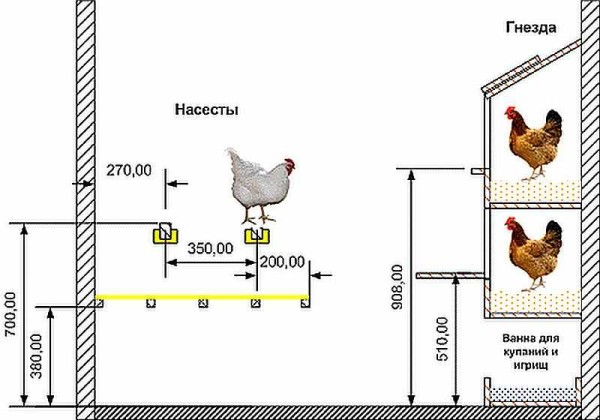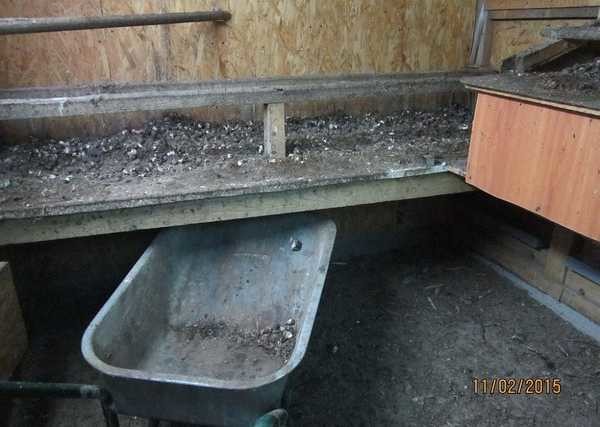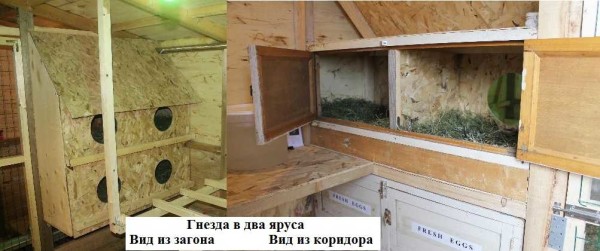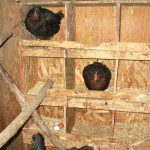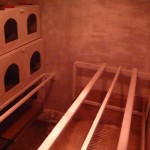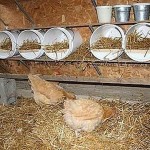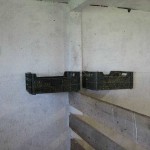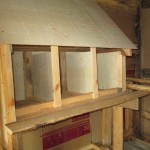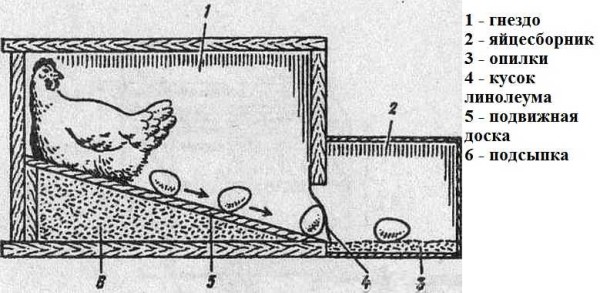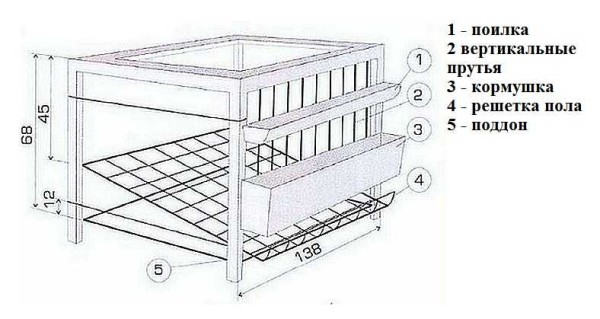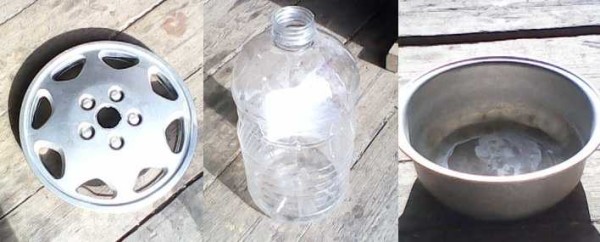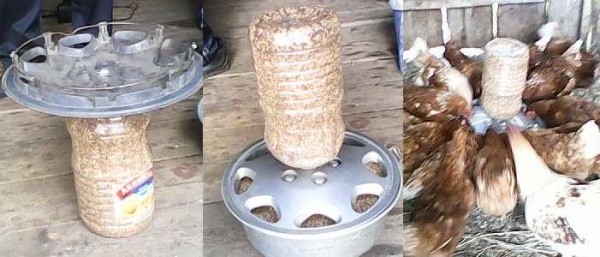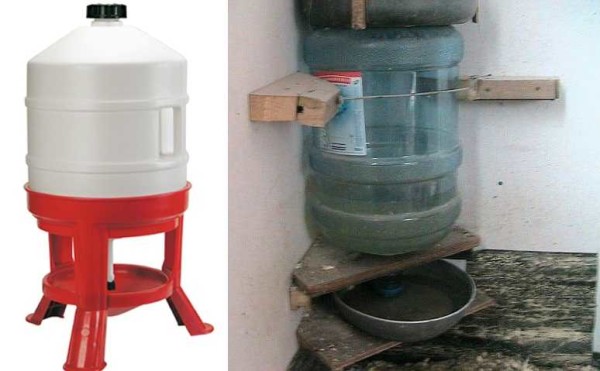Coop inside: what is needed and how to do it
It is not enough to build a good shed for chickens, you also need to equip it: fix the perches, make nests, put / hang drinkers, feeders. But this should be done so that it is convenient for you to maintain the poultry house. Chickens don't really care how beautiful their nests are. They will sit perfectly on the floor. It will be inconvenient for you to collect eggs from the floor, and they may even be pecked. Therefore, we make the arrangement of the chicken coop so that it is more convenient for you.
The content of the article
Perches
First of all, you need to equip the chicken coop inside with perches. This is a round or oval stick - a tree branch, a shovel handle, a rounded bar, etc., fixed at some height above the floor.
On average, they take about 20-25 cm of perch length per chicken. They are fixed from the wall at a distance of 25-30 cm, one perch from another - at a distance of 35-40 cm. You can make multi-tiered, but there will be fights for the highest place. Keep in mind that all dimensions are approximate only and are necessary to be able to navigate. Everything is selected more according to the place: both breeds and chicken coops, and their owners too.
To make it easier to clean, a shield made of some smooth material is installed at a distance of 20 cm below the perch. Dung accumulates on it, so choose a smooth surface: it will be easier to sweep.
The question remains: at what height should the roost be made, and hence the shield? The most convenient way to clean is in the cart. She should drive under the shield so that you can dump the litter directly into the wheelbarrow with a hoe. In the flood, the height of the shield is determined by the height of your wheelbarrow, and above the shield there will already be roost bars. And again, you choose the height of the perch for chickens so that it is convenient to clean.
Nests
The second required element in arranging a chicken coop is a nest. They will rush on the floor, but the eggs will be dirty, and they can even peck. According to the norms, one nest is made for three chickens. But in fact, it turns out that how many of them do not do, they choose one or two, maximum - three and stand in line in them. The rest are exactly the same next to each other, empty. Periodically, their tastes change, they begin to rush to others ... From all this it follows that you can safely count 5-6 heads per nest, anyway half will be empty.
It is better to arrange the nests so that it is convenient for you to pick up eggs, i.e. hang on the wall. So that the bird could get there safely, they make traps - an inclined board with perches / sticks nailed across. The same ladders are made for perches. If nests are placed near the perches and at the same approximately level, they will go back and forth. Quite convenient.
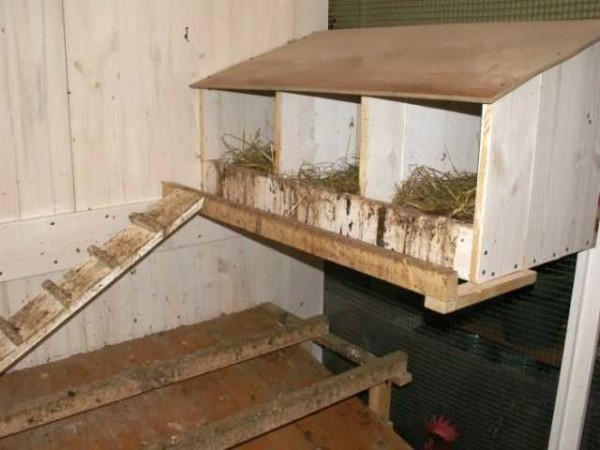
You can make such civilized nests
If possible, make sure that the back side of the nests goes out into the corridor, if any. A door is made from the back. Then, to pick up the eggs, you do not need to go into the pen - they opened the doors, collected them.
Chickens also love to lay in the dark, or at least in dim light. Therefore, the entrance is made small, and so that they do not sit inside for a long time, sleep and do not spoil, the roof is made with a strong slope (pictured).
You can simply arrange or hang boxes along the wall, but arrange blackout by placing a partition in front of the nests. In general, it is difficult to predict their behavior. It happens that the nests are simply ignored, rushing anywhere. Then a stencil or mock-up can help: cut an egg out of white paper and put it in a nest. It can help: they will rush there.
Several nests in different designs are shown in the photo below. These are all real chicken coops, you can use them.
- Chose one nest on each tier
- This is the arrangement of a new chicken coop
- Plastic is very practical: easy to wash, inexpensive, you can do a lot
- Chickens are very fond of such plastic nests. They put more hay in them - they rush
- The place below can be taken under the roosts or hung on the bottom of an IR lamp - make a solarium
In the nest, you always act with caution with your hands: you never know what chickens have carried there ... It is much more convenient and safer when the eggs roll into a special compartment - the egg receptacle. The main snag in this device: choose the angle of inclination of the floor and flexible material so that the egg pushes it away and stops without reaching the wall. To soften the "landing", sawdust is poured on the bottom.
Since the eggs roll down and the bird does not see them, they may refuse to lay in such nests. In this case, you can make a dummy egg - from dense foam to full size or cut a stencil from paper - and glue it to the bottom. This almost always works.
Read how to make a warm chicken coop here.
Chicken cages
Sometimes the bird is kept in cages. But this is with industrial or semi-industrial content. With this method of cultivation, a large number of birds live in a small area. A drawing of a cage for chickens with dimensions is posted below.
All sizes are according to the standards, and you don't need to invent anything. This is the minimum required for layers. And what can be obtained from such cells in the photo below.
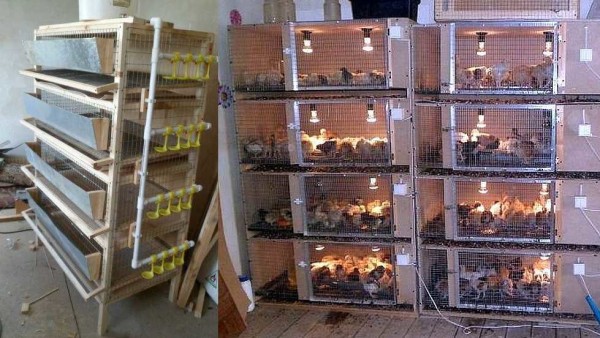
Laying cages
How to make cages for broilers from wood, see the video. Everything is painted in great detail: what, why, what sizes, how to assemble and what is needed for this. Really helpful.
Drinking troughs
The arrangement of a chicken coop is unthinkable without drinking bowls and feeders. Little of, in summer walking they should be too. Feeders are periodic and bunker. Periodic - this is when you came in, poured the feed rate and that's it. They stand empty until the next feeding.
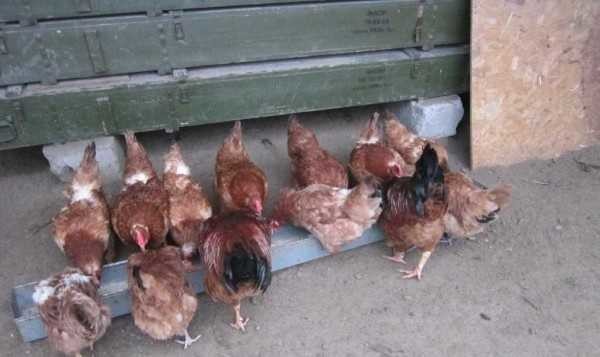
Climbing and digging is a favorite thing
Bunker is when there is a decent supply of feed, which is constantly poured into some kind of container. Both have disadvantages: periodic ones - each time you need to go to the chicken coop and pour grain, and the bird also crowds, fights for the best place, which sometimes leads to the fact that the feeder is turned over.
If you have a bunker feeder, you need to walk much less often, but there is an opportunity to overfeed the bird, which is a disaster for layers. Therefore, either laying hens are given a large walk or only broilers are fed in this way.
There are a lot of designs of periodic feeders, but not all of them allow you to use feed economically. The easiest way is to put the food in a bowl or container. But, if there is at least some opportunity, the chickens begin to rake the feed, pouring it out and then trample it. We have to throw it away. And such feeders allow not only digging in the feed, but also getting into the feeder with your feet. Therefore, they need to be improved. For this, wire separators are installed on the container. Feed consumption decreases dramatically: it is more difficult to remove it.
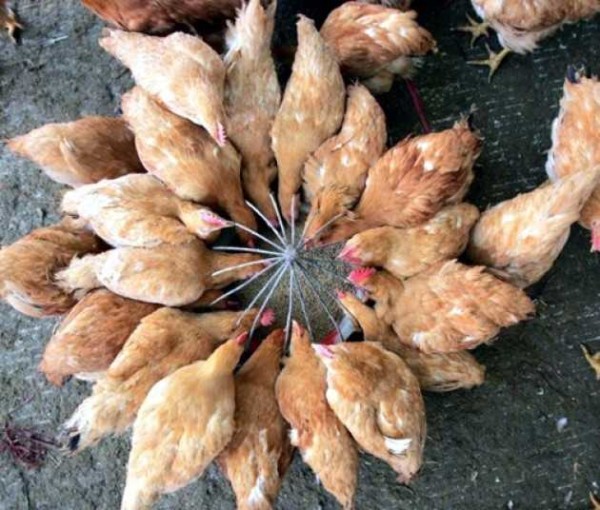
Divider feeder
You can make, for example, another similar feeder (or drinker), which is conveniently attached or stands against the wall. It is probably easier to weld it from metal, although there are craftsmen who will make something similar from wood.
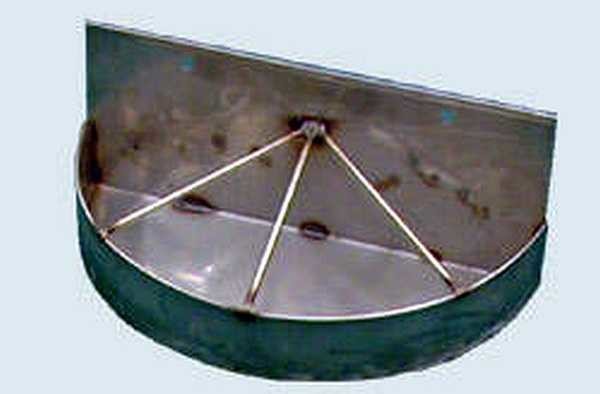
Convenient feeder for chickens: there is little space and it costs firmly, and you can hang it
There are some interesting ideas. For example, an economical auto-feeder is assembled from an old disc for a car, a bowl of a suitable diameter and a plastic water bottle with a capacity of 5-10 liters.
Look for a disc of the type shown in the photo: with a large number of small holes along the outer edge. In its middle, cut a hole to fit the neck of the bottle. Cut out the bottom in the bottle cap, leaving only the threaded ring. The fodder mixture is poured into the bottle, a disk is put on it, and it is pressed with a cut lid.Feed is poured into the basin, a structure is installed on top.
In order not to disassemble the feeder every time, when it is necessary to pour it into the bottle of feed, you can cut the bottom, making a kind of lid out of it. Then the bottle itself can be fixed more seriously: fixing with a thread from the lid is not very reliable. But such an improvement does not allow rummaging in the stern, and no one will get into the basin either.
You can make a feeder out of a piece of plastic sewer pipe. Holes with a diameter of about 7 cm are cut on both sides. They do not have to be made round at all - square or rectangular will also work. At the ends, a corner is installed at 90 ° with a socket upwards and along a small piece of pipe: you can pour food here.
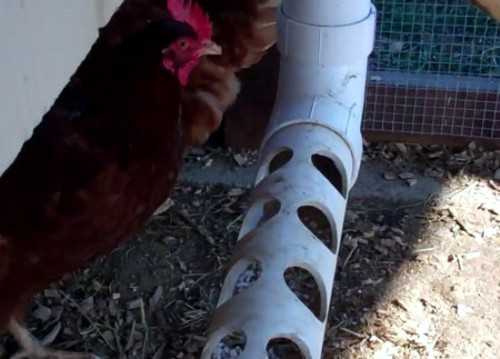
Feeder for a chicken coop from a plastic pipe. Suitable also as a drinker
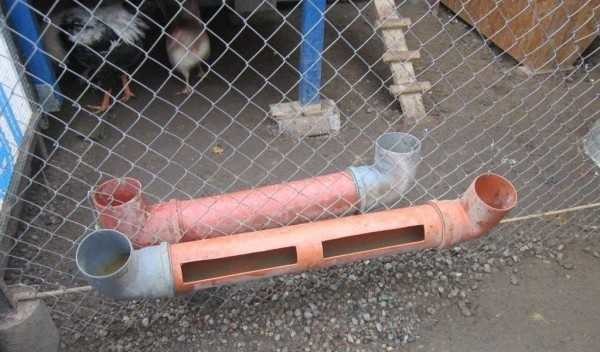
The second version of the PVC pipe feeder chicken
A simple but roomy bunker trough is a decent chest with a folding bar attached at the bottom. In the open position, food is poured onto it.
Another option for an economical feeder is made of plastic sewer pipes. But this is already a bunker design: a decent stock. The design is simple and the consumption is reduced.
An even more interesting design of a chicken feeder in the video: with a lid. To open it, you need to jump on it.
Another option for a bunker feeder made of PVC pipes and a plastic bottle from under the water.
Read how to make beautiful beds here.
Homemade drinking bowls for chickens
Drinking bowls are almost the same story. Only here water is sprayed, which, when mixed with droppings, gives an extremely persistent odor, as well as dirt. All this does not contribute to an easier and faster cleaning. Therefore, the choice of drinkers is no less important than the feeders.
The simplest option for a small number of birds - up to 15 pieces - are siphon drinkers. They are on legs, allow you to use water sparingly. If the legs are well designed, even a chicken that has flown to the top does not knock them over.
Factory drinkers, of course, look more attractive, but a home-made option is almost for nothing, and they work just as well. In the photo you see a simple homemade siphon drinker for chickens: a support was nailed in the corner - a piece of board with a cut-out hole for the neck. Above - a fastening system, and a load so as not to be knocked down. In the former bottom of the bottle, a hole is cut into which water is poured. The whole trick here is to choose the distance at which to install the water container: so that it is not too little or too much.
Drinking bowls are convenient for growing in cages, as they are conveniently attached to the net. But no one bothers to hang a piece of mesh, say on a wall or come up with another mount.
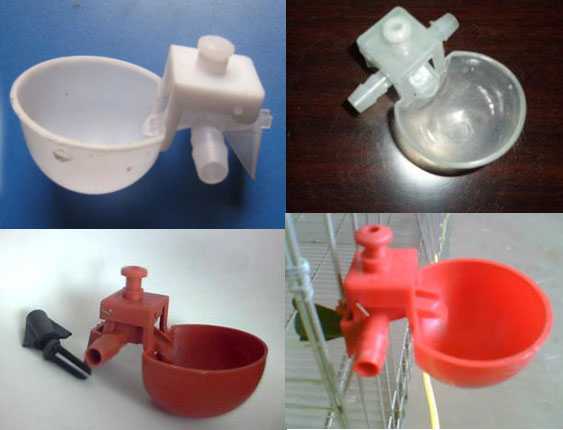
Cup drinkers for poultry (including chickens)
They allow you to water the birds without splashing. Water is fed into the cup, it tilts under the influence of gravity, shutting off the supply. We drank the water, the cup rose, the water flows again. A hose is connected to the side fitting, the second end of which is in a container with water, which should stand above the level of the drinkers. Convenient and economical.
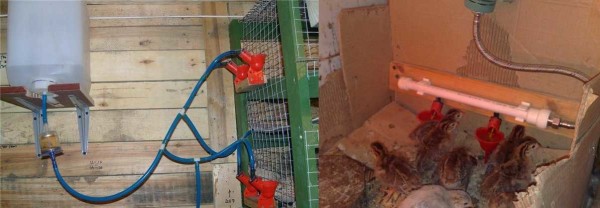
Installation options for drinking bowls
Nipple drinkers for chickens. These are small devices, a few centimeters in size. A cone-shaped stainless steel rod is inserted into the plastic case.
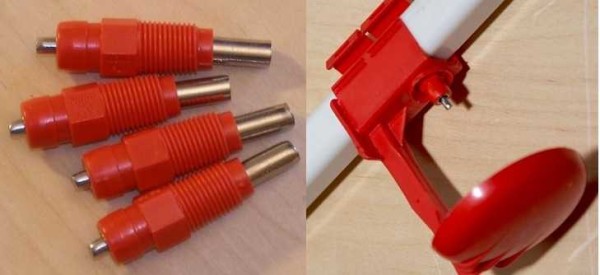
Nipple drinkers
These nipples are screwed into plastic pipes that supply water. A hole of the required diameter is drilled, a thread is cut and the nipple is screwed in. When you press the rod, a few drops of water appear. Chickens peck at the rod, drinking the drops that appear. The main disadvantage of this method is drops that fall to the floor. To prevent this from happening, a special drop catcher is placed under each drinker. It just snaps onto the pipe.
For all their diminutiveness, these small drinkers cost a lot, especially if they are of high quality - read - imported. Ours, of course, are cheaper, but break down faster.
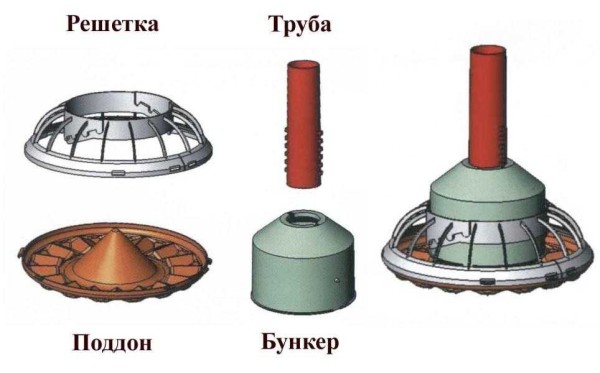
Small drinking bowl for chicks or quails
And the rest are different cups and basins into which water is simply poured. Their disadvantage is that birds often turn them over, and the water in them quickly gets dirty.
There are also interesting ideas from homemade ones. For example, such a drinking bowl from a pipe is shown in the photo. In a piece of plastic pipe, the water level is controlled by a float mechanism from the toilet bowl. Three drinking bowls are attached to the pipes.
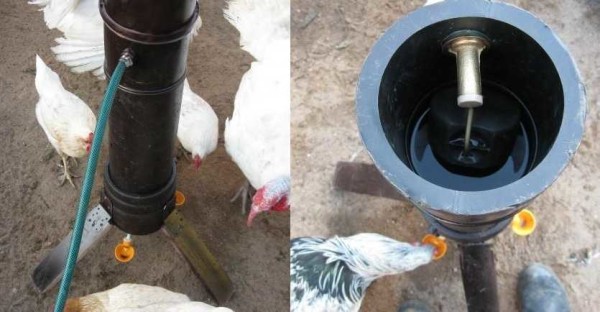
Attached to the pipe are three drinking bowls
The video shows a drinking bowl with auto-fill.
If there is a desire to equip the chicken coop, it is possible so as to minimize the need for its maintenance. In this case, the bird will bring not only income, but also pleasure: it is always pleasant to look at hand-made objects, and keeping a bird in a chicken coop without "straight" hands is difficult and expensive.

